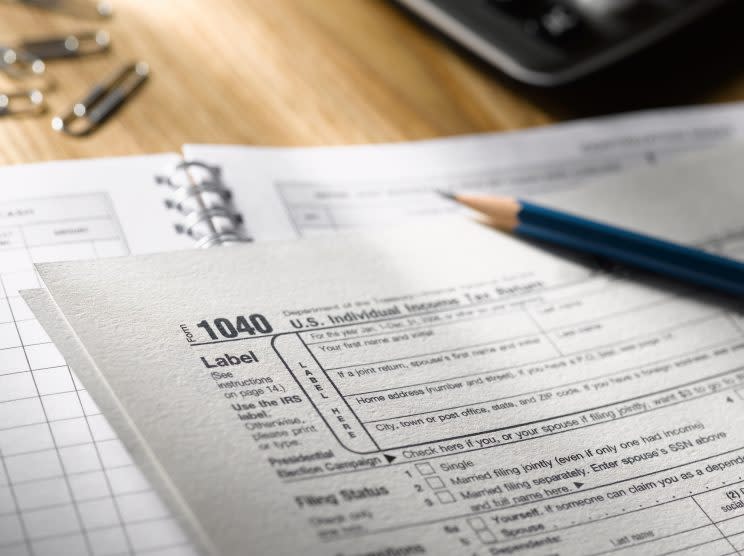5 things to do by New Year's Eve to lower your tax bill

With Christmas, Hanukkah and New Year’s Eve approaching, taxes are probably the last thing on your mind. After all, the filing deadline isn’t until April 18. But with just 4 weeks left of 2016, there are a few things you can still do to save.
1. Make charitable contributions
Many of us have heard this advice before, but it bears repeating. Charitable donations are an easy way to get a tax deduction, and the most obvious way to make a donation is to write a check. However, there are a handful of other ways you can give back. Clean out your closet and donate clothes, or go through your living room for household goods you’re no longer using. According to the IRS, a donor claiming a deduction of $250 or more is required to obtain and keep a written acknowledgment for a charitable contribution, so be sure to get a donation receipt. It’s also a good idea to take a photo of your contribution, just as back-up.
Also, making a donation with your credit card this month means you don’t have to pay it off until January – and you still get the deduction, says Lisa Greene-Lewis, CPA with TurboTax.
2. Reduce your income
Your tax bracket depends on your income. So if your 2016 income could bump you into a higher tax bracket, consider reducing your income before the end of the year. (Tip: Use this tax calculator to predict how much you’ll owe after filing.)
Here are some ways to do it:
Maximize your retirement contributions
One easy way to do this is to boost contributions to your retirement account. If you haven’t reached your maximum 401(k) contribution for the year (up to $18,000 if you’re under 50, $24,000 if you’re over 50), consider doing so now. If you’re in the 28% tax bracket, for example, you could save $280 in current-year taxes for every additional $1,000 you contribute up to the 2016 limit, Fidelity says.
If you get an employer match, “then that’s another win because you’re putting twice the money in your retirement and reducing your taxable income,” says Greene-Lewis.
If you don’t have a 401(k), you can contribute to an Individual Retirement Account (IRA), which allows your money to grow tax-free. People under 50 can contribute $5,500 a year to an IRA. That number jumps to $6,500 if you’re over 50. You can make 2016 IRA contributions until April 17, 2017, but why procrastinate? Do it by the end of 2016 so you don’t have to think about it in the new year.

Defer your bonus
A holiday bonus is a great surprise, but if it’s going to bump you into the next tax bracket, it could become an issue around tax time. Instead of using your bonus to pay taxes, it could be strategic to ask your employer to hold off on giving you a bonus until January. This way, you’re still getting your money, but you won’t pay a higher tax rate for 2016.
Accelerate deductions
If you know your income will be lower in 2017, it might be a good idea to accelerate some of your deductions as a way of reducing your tax liability this year. To put it simply, you will pay less in taxes if you have more deductions. Some examples of accelerating deductions include replacing old business equipment, prepaying state income taxes, or paying next year’s fees and subscriptions in the current year.
If you own your home, Greene-Lewis suggests making an extra mortgage payment at the end of the year so you get an additional tax deduction for the interest paid. “Get an additional deduction this year, instead of waiting,” she says.
Added bonus of reducing income
Another benefit of lowering your taxable income is that it could help you get a healthcare credit. Some people who buy insurance through the HealthCare.gov marketplace qualify for a tax credit – based on income – that lowers their premium. If you lower your income, that premium tax credit will increase.
3. Use money in your FSA
A Flexible Spending Account (FSA) is set up to pay for out-of-pocket healthcare expenses, and is funded with pre-tax money. The most you can put in an FSA is $2,550 a year per employer, and in most cases you’re encouraged to spend the money in your account by the end of the year. Your employer might offer a grace period of two-and-a-half extra months or allow you to carry up to $500 into the next year — but neither of these options are required. If you haven’t spent all your FSA money yet, now’s the time spend it before it might be gone. And you don’t have to spend it on doctor’s appointments and needless tests. The list of eligible expenses covered by FSA money is pretty extensive – it includes dental visits, teeth cleaning, eye exams, contact lenses, glasses, acupuncture treatments, flu shots, fertility treatments, physical therapy, pregnancy tests, aspirin and more. (Here’s the full list).

4. Make your home energy efficient
If you’ve been toying with the idea of installing energy efficient windows in your home, there is no better time than now. If you make a qualified energy-saving home improvement by the end of the year, you can claim a tax credit of up to 30% of the cost. Other qualifying improvements include solar panels for generating electricity, solar-powered water heaters, wind turbines that generate up to 100 kilowatts of electricity, geothermal heat pumps and fuel cells that rely on a renewable resource to generate power for a home.
5. Further your education
If you take a course to advance your career or build your business, it can be used as a tax deduction. If you’re enrolled or taking classes at an eligible educational institution, you might qualify for the Lifetime Learning Credit (LLC), which could be worth up to $2,000 per tax return. If your modified adjusted gross income (for most people this is the same as your adjusted gross income or AGI) is over $65,000 you cannot claim the credit. Joint filers do not qualify if they make over $130,000.
Brittany is a writer at Yahoo Finance.
Read more:
Forget Airbnb, try these other popular vacation rentals

 Yahoo Finance
Yahoo Finance 
